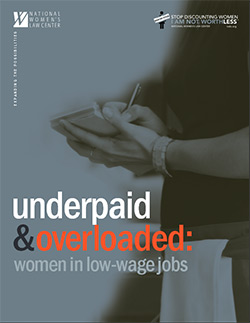Executive Summary of National Women’s Law Center Report
…Women make up two-thirds of the nearly 20 million workers in low-wage jobs—defined in this report as jobs that typically pay $10.10 per hour or less—although they make up slightly less than half of the workforce as a whole.
The low-wage workforce includes jobs such as home health aides, child care workers, fast food workers, restaurant servers, maids, and cashiers. The work is hard and necessary, but the pay is inadequate. At $10.10 per hour, a full-time, year-round worker earns $20,200 annually—barely above the poverty line for a mother with two children. Many of the workers in these jobs are paid the minimum wage of $7.25 per hour; at that rate, a full-time, year-round worker would earn just $14,500—thousands of dollars below the poverty line for a family of three. Full Report
Women’s concentration in low-wage jobs has increased in recent years—and the trend is likely to continue. More than one-third (35 percent) of women’s net job gains during the recovery from the Great Recession have been in jobs that typically pay $10.10 per hour or less; only 20 percent of men’s job gains have been in such low-wage jobs. The share of women workers who hold low-wage jobs increased by more than six percent between 2007, the year before the recession, and 2012, despite women’s continued advances in education. And disproportionately strong growth in low-wage, female-dominated jobs is projected for the future. Of the 20 jobs predicted to add the largest numbers of workers between 2012 and 2022, five are low-wage, typically paying less than $10.10 per hour—and all of these low-wage jobs are female-dominated. Another nine of these 20 high-growth jobs pay between $10.10 per hour and the median wage of $16.71 per hour—and five of these jobs are female-dominated.
Women’s overrepresentation in low-wage jobs is a particular concern today because families’ reliance on women’s earnings has increased dramatically over the past 40 years. Working mothers are primary breadwinners in 41 percent of families with children, and they are co-breadwinners—bringing in between 25 percent and 50 percent of family earnings—in another 22 percent of these families. At the same time, women still shoulder the majority of caregiving responsibilities. And the characteristics of low-wage jobs pose particular challenges to women as both breadwinners and caregivers.
This analysis focuses on the role of gender in the low-wage workforce, using data on worker characteristics from the Current Population Survey and American Community Survey and data on median hourly wages for occupations from the Bureau of Labor Statistics’ Occupational Employment Statistics. It reveals a stark reality: regardless of their education level, age, marital or parental status, race, ethnicity, or national origin, women make up larger shares of the low-wage workforce than do their male counterparts. This pattern holds in each of these groups, even though in virtually all of them women represent a similar or smaller share of the overall workforce than their male counterparts. Looking at the data another way, comparing women’s and men’s shares of the low-wage workforce to their respective shares of the overall workforce, nearly every group of women is overrepresented in the low-wage workforce; for men, this is rarely true.
The existence of a wage gap between women and men at every education level has been well documented. However, the finding that in this day and age, women need a bachelor’s degree to avoid being overrepresented in low-wage jobs—while men only need to finish high school—is startling. Moreover, even in these low-wage jobs, women working full time, year round face a 13 percent wage gap, and the gap is even larger for African American and Hispanic women when compared to white, non-Hispanic men.
The overrepresentation of women in low-wage jobs occurs across the country. In every state, at least six in ten low-wage workers are women, even though women make up half or less of the overall workforce in every state. Women make up at least twice as large a share of the low-wage workforce as men in all but three states and the District of Columbia—and in nine states, women’s share of the low-wage workforce is more than 2.5 times that of men.
This report also provides a profile of the women who work in low-wage jobs. Nearly half are women of color. Half work full time—and nearly one in five is poor. Nearly one-third are mothers—and 40 percent of mothers in the low-wage workforce have family incomes below $25,000. More than one-quarter of the women working in low-wage jobs are age 50 and older; they make up nearly the same share of the female low-wage workforce as women age 16 to 24.
Low earnings are just one of the challenges workers in low-wage jobs face. These jobs often lack basic benefits such as paid sick leave, and, while the Affordable Care Act (ACA) has significantly improved women’s access to affordable health insurance, workers in these jobs may still face barriers to health insurance coverage and services they need, including reproductive health care services. Mothers struggle to afford the safe and stable child care they need to be able to work—much less the high-quality child care their children need to be successful in school. Women working in low-wage jobs, especially women of color, often face discrimination and harassment. They also can be subject to unpredictable and inflexible work schedules, which are particularly difficult for workers balancing family or school responsibilities or trying to hold down a second job to make ends meet. Taken together, these challenges create significant obstacles to moving out of low-wage work and into good jobs that can sustain a family.
The predominance of women in low-wage jobs makes clear that an economic agenda that works for women must address the particular needs of low-wage workers—and an economic agenda that works for low-wage workers must address the particular needs of women. Moreover, jobs that typically pay low wages, such as home care aides who provide critical services to an expanding elderly population, are a critical and growing part of our economy. Ensuring that workers in those jobs are treated fairly and can provide for their families is vital not only for them, but for the nation as a whole.
This report outlines an agenda to address the needs of women in low-wage jobs by:
- increasing economic security through a combination of higher wages—starting with raising the minimum and tipped minimum wages—and other supports, such as the Earned Income Tax Credit, affordable health insurance, nutrition and housing assistance, and removing restrictions on women’s access to reproductive health care;
- supporting workers with family responsibilities by expanding access to child care assistance and early education, curbing abusive scheduling practices, and ensuring paid sick days and paid family leave;
- removing barriers to opportunity by strengthening and enforcing protections against all forms of employment discrimination and providing a path to citizenship for immigrants who are particularly vulnerable to discrimination;
- creating pathways to opportunity by making higher education more affordable, enforcing legal protections for pregnant and parenting students and increasing student-parents’ access to child care, and expanding women’s access to higher-paying, nontraditional fields; and
- strengthening opportunities for collective action, including supporting organizing and collective bargaining through traditional unions and collective action by new worker justice organizations.
These policies will not only improve the lives of workers in low-wage jobs—women and men—and their families, but will make our economy stronger for everyone.


